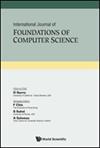最佳嵌入和包围等腰三角形
IF 0.6
4区 计算机科学
Q4 COMPUTER SCIENCE, THEORY & METHODS
International Journal of Foundations of Computer Science
Pub Date : 2023-10-05
DOI:10.1142/s012905412342008x
引用次数: 0
摘要
给定一个三角形[公式:见文],我们研究了在面积和周长方面确定[公式:见文]的最小包围三角形和最大嵌入等腰三角形的问题。这个问题最初由Nandakumar提出[17,22],Kiss, Pach和Somlai[13]首先进行了研究,他们表明,如果[公式:见文]是包含[公式:见文]的最小面积等腰三角形,那么[公式:见文]和[公式:见文]共用一条边和一个角。本文证明了对于任意三角形[公式:见文],嵌在[公式:见文]中的每个最大面积等腰三角形和嵌在[公式:见文]中的每个最大周长等腰三角形与[公式:见文]共用一条边和一个角。令人惊讶的是,最小周长包围三角形的情况是不同的:有无限的三角形族[公式:见文本],其最小周长等腰容器不与[公式:见文本]共享一条边和一个角。本文章由计算机程序翻译,如有差异,请以英文原文为准。
Optimal Embedded and Enclosing Isosceles Triangles
Given a triangle [Formula: see text], we study the problem of determining the smallest enclosing and largest embedded isosceles triangles of [Formula: see text] with respect to area and perimeter. This problem was initially posed by Nandakumar [17, 22] and was first studied by Kiss, Pach, and Somlai [13], who showed that if [Formula: see text] is the smallest area isosceles triangle containing [Formula: see text], then [Formula: see text] and [Formula: see text] share a side and an angle. In the present paper, we prove that for any triangle [Formula: see text], every maximum area isosceles triangle embedded in [Formula: see text] and every maximum perimeter isosceles triangle embedded in [Formula: see text] shares a side and an angle with [Formula: see text]. Somewhat surprisingly, the case of minimum perimeter enclosing triangles is different: there are infinite families of triangles [Formula: see text] whose minimum perimeter isosceles containers do not share a side and an angle with [Formula: see text].
求助全文
通过发布文献求助,成功后即可免费获取论文全文。
去求助
来源期刊

International Journal of Foundations of Computer Science
工程技术-计算机:理论方法
CiteScore
1.60
自引率
12.50%
发文量
63
审稿时长
3 months
期刊介绍:
The International Journal of Foundations of Computer Science is a bimonthly journal that publishes articles which contribute new theoretical results in all areas of the foundations of computer science. The theoretical and mathematical aspects covered include:
- Algebraic theory of computing and formal systems
- Algorithm and system implementation issues
- Approximation, probabilistic, and randomized algorithms
- Automata and formal languages
- Automated deduction
- Combinatorics and graph theory
- Complexity theory
- Computational biology and bioinformatics
- Cryptography
- Database theory
- Data structures
- Design and analysis of algorithms
- DNA computing
- Foundations of computer security
- Foundations of high-performance computing
 求助内容:
求助内容: 应助结果提醒方式:
应助结果提醒方式:


